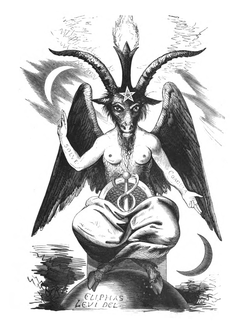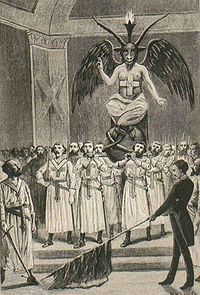Baphomet

Baphomet is a name of unestablished provenance. It first appeared in trial transcripts during the Inquisition of the Knights Templar in the early 1300s. Some modern scholars believe the name to have been an Old French corruption and misspelling of the name Mahomet (Muhammad).[1] See Etymology[1] below, for a list of possible origins.
However, in the 19th century the name came into popular English-speaking consciousness with the publication of various pseudo-history works that tried to link the Knights Templar with conspiracy theories elaborating on their suppression. The name Baphomet then became associated with a "Sabbatic Goat" image drawn by Eliphas Lévi.
Eliphas Levi and Baphomet
In the 19th century, the name of Baphomet became associated with occult. In 1854, Eliphas Levi published Dogme et Rituel de la Haute Magie ("Dogmas and Rituals of High Magic"), in which he included a drawing he described as Baphomet and "The Sabbatic Goat", showing a winged humanoid goat with a pair of breasts and a torch on its head between its horns (illustration, top). This image has become the most well-known representation of Baphomet. Levi's depiction is similar to that of the Devil in the Tarot, but it may also have been partly inspired by grotesque carvings on the Templar churches of Lanleff in Brittany and St. Merri in Paris, which depict squatting bearded men with bat wings, female breasts, horns and the shaggy hindquarters of a beast.[2][3]
Lévi considered the Baphomet to be a depiction of the absolute in symbolic form and explicated in detail his symbolism in the drawing that served as the frontispiece:
"The goat on the frontispiece carries the sign of the pentagram on the forehead, with one point at the top, a symbol of light, his two hands forming the sign of hermetism, the one pointing up to the white moon of Chesed, the other pointing down to the black one of Geburah. This sign expresses the perfect harmony of mercy with justice. His one arm is female, the other male like the ones of the androgyn of Khunrath, the attributes of which we had to unite with those of our goat because he is one and the same symbol. The flame of intelligence shining between his horns is the magic light of the universal balance, the image of the soul elevated above matter, as the flame, whilst being tied to matter, shines above it. The beast's head expresses the horror of the sinner, whose materially acting, solely responsible part has to bear the punishment exclusively; because the soul is insensitive according to its nature and can only suffer when it materializes. The rod standing instead of genitals symbolizes eternal life, the body covered with scales the water, the semi- circle above it the atmosphere, the feathers following above the volatile. Humanity is represented by the two breasts and the androgyn arms of this sphinx of the occult sciences."
Levi called his image “the Baphomet of Mendes”, presumably following Herodotus' account[4] that the god of Mendes — the Greek name for Djedet, Egypt — was depicted with a goat's face and legs. Herodotus relates how all male goats were held in great reverence by the Mendesians, and how in his time a woman publicly copulated with a goat.[5] However the deity that was venerated at Egyptian Mendes was actually a ram deity Banebdjed (literally Ba of the lord of djed, and titled "the Lord of Mendes"), who was the soul of Osiris. Levi combined the images of the Tarot of Marseilles Devil card and refigured the ram Banebdjed as a he-goat, further imagined by him as "copulator in Anep and inseminator in the district of Mendes".
Criticism of Levi's interpretation
Egyptian connections aside, Lévi's depiction, for all its modern fame, does not match the historical descriptions from the Templar trials, although it is akin to some grotesques found on Templar churches.
Critics argue that Lévi and other writers, such as Albert Pike, were attempting to use the false accusations against the Templars to fabricate from the name Baphomet a veritable Deity of Hedonism and Rebellion against a Christian establishment. Levi's now-familiar image shown here as a "Sabbatic Goat" shows parallels with works by the Spanish artist Francisco Goya, who more than once painted a "Witch's Sabbath"; in the version ca 1821-23, El gran cabrón now at the Prado, a group of seated women offer their dead infant children to a seated goat. Levi also incorrectly identified Baphomet with Herodotus' mistaken "Goat of Mendes".
Aleister Crowley and Baphomet
Aleister Crowley's further fanciful connections linked the ram-god of Mendes with the syncretic Ptolemaic-Roman Harpocrates, a version elaborated upon the child-form of the Egyptian god Horus. Harpocrates was a granter of fertility, but he was not associated with debauch or lust -- and, most important, in animal-form, he was a ram, not a buck goat.
The Baphomet of Lévi was to become an important figure within the cosmology of Thelema, the mystical system established by Crowley in the early twentieth century. Crowley identified Baphomet with Harpocrates and also with what he called the Lion-Serpent. Crowley agreed that Baphomet was a divine androgyne, while also being bi-sexual (as Crowley was) and "the hieroglyph of arcane perfection"[6]. In The Law is for All[7] Crowley identifies the Lion-Serpent with one's "Secret Self", which he also called the Holy Guardian Angel.
In Magick (Book 4), Crowley writes, "The devil is this serpent, Satan. He is life and love. He is light, and his zodiacal image is Capricornus, the 'leaping goat,' 'the god head.'"[8]
For Crowley, Baphomet is further a representative of the spiritual nature of the spermatozoa while also being symbolic of the "magical child" produced as a result of sex magic. As such, Baphomet represents the Union of Opposites, especially as mystically personified in Chaos and Babalon combined and biologically manifested with the sperm and egg united in the zygote.

But Crowley saw Baphomet as more than the Union of Opposites—-he is also the Lust that leads to such Union. Baphomet is depicted in Crowley's Thoth Tarot deck, in the card "Devil" (Atu XV). Here, he is identified with the Greek god Pan, the All-Begetter. He is "creative energy in its most material form [...], the goat leaping with lust upon the summits of earth [...], the divine madness of spring"[9]
Crowley, who was known as "The Beast,"[8] also identified himself with Baphomet. In The Equinox of the Gods he describes another card from the Tarot, this time "Lust" (Atu XI), "It shows the Scarlet Woman, BABALON, riding (or conjoined with) me The Beast ; and this card is my special card, for I am Baphomet, 'the Lion and the Serpent,' and 666, the 'full number' of the Sun" [10] It is perhaps for this reason that Crowley assumed the magical name of Baphomet when he was risen to the X° within Ordo Templi Orientis.
Baphomet as a demon

Baphomet, as Lévi's illustration suggests, has occasionally been portrayed as a synonym of Satan or a demon, a member of the hierarchy of Hell. Baphomet appears in that guise as a character in James Blish's The Day After Judgment. Christian evangelist Jack Chick claims that Baphomet is a demon worshipped by Freemasons, a claim that apparently originated with the Taxil hoax.[11]. Léo Taxil's elaborate hoax employed a version of Lévi's Baphomet on the cover of Les Mystères de la franc-maçonnerie dévoilés, his lurid paperback "exposé" of Freemasonry, which in 1897 he revealed as a hoax satirizing ultra-Catholic anti-Masonic propaganda. Lévi's Baphomet is clearly the source as well of the later Tarot image of the Devil, in the Rider-Waite design. The downward-pointing pentagram on its forehead is enlarged upon by Lévi in his illustration of a goat's head arranged within such a pentagram, which he contrasts with the microcosmic man arranged within a similar but upright pentagram.[12]
The symbol of the goat in the downward-pointed pentagram was adopted as the official symbol—called the Sigil of Baphomet—of the Church of Satan, and continues to be used amongst Satanists.
Etymology
Several competing theories exist for the origin of the mysterious name Baphomet. These include:
- Some modern scholars believe the origin of the name Baphomet to have been a French misspelling of "Mahomet" (i.e., "Muhammad").
- Emile Littré (1801-1881) in Dictionnaire de la langue francaise asserted that the word was cabalistically formed by writing backward tem. o. h. p. ab an abbreviation of templi omnium hominum pacis abbas, 'abbot' or 'father of the temple of peace of all men.' His source is the "Abbé Constant", which is to say, Alphonse-Louis Constant, the real name of Eliphas Lévi.
- Idries Shah proposed that "Baphomet" may derive from the Arabic word ابو فهمة Abufihamat, meaning "The Father of Understanding".[13]
- Atbash cipher for Sophia. Dr Hugh J. Schonfield,[14] one of the scholars who worked on the Dead Sea Scrolls, argued in his book The Essene Odyssey that the word "Baphomet" was created with knowledge of the Atbash substitution cipher, which substitutes the first letter of the Hebrew alphabet for the last, the second for the second last, and so on. "Baphomet" rendered in Hebrew is בפומת; interpreted using Atbash, it becomes שופיא, which can be interpreted as the Greek word "Sophia", or wisdom. This theory is an important part of the plot of The Da Vinci Code.
- The Rev. Alphonsus Joseph-Mary Augustus Montague Summers (1880-1948), compiler of The History of Witchcraft and Demonology (1926) and The Geography of Witchcraft (1927) was able to form Baphomet from the Greek words 'baphe and 'Metis'. The two words together would mean "Baptism of Wisdom".
See also
Notes
- ^ Malcolm Barber, p. 321
- ^ Jackson, Nigel & Howard, Michael (2003). The Pillars of Tubal Cain. Milverton, Somerset: Capall Bann Publishing. p. 223.
- ^ Comparison of these images from about.com
- ^ Herodotus, Histories ii. 42, 46 and 166.
- ^ Herodotus, Histories ii. 156.
- ^ Magick, Ch.21
- ^ Magick, p. 95.
- ^ a b The Illuminati (2005); Chapter: The Illuminati's Tarnished Crown, a film by Chris Everard of EnigmaTV.
- ^ Magick, p. 105.
- ^ Magick, Ch.7
- ^ "Leo Taxil's confession".
- ^ What do the symbols hide? Retrieved 28 June 2006.
- ^ Daraul, Arkon. A History of Secret Societies. ISBN 0-8065-0857-4.. "Arkon Daraul" is widely thought to be a pseudonym of Idries Shah
- ^ Hugh J. Schonfield, The Essene Odyssey. Longmead, Shaftesbury, Dorset SP7 8BP, England: Element Books Ltd., 1984; 1998 paperback reissue, p.164.
References
- {{Harvard reference |Surname=Barber |Given=Malcolm|Authorlink=Malcolm Barber |Year=1994 |Title=The New Knighthood: A History of the Order of the Temple |Place= |Publisher=Cambridge
- Template:Harvard reference
- Template:Harvard reference
- Template:Harvard reference
- Template:Harvard reference
- Martin, Sean (2005), The Knights Templar: The History & Myths of the Legendary Military Order. ISBN 1-56025-645-1.
- Read, Piers Paul (1999), The Templars. Da Capo Press, ISBN 0-306-81071-9.
